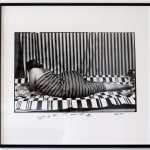





Malick Sidibé
Vue de Dos, 2011
Gelatin Silver Print
120 x 120 cm
Copyright The Artist
Further images
Art Historian Sylvia Boone research on women in Mende and Malian culture: “Movement, not nudity, is crucial to understanding the poetics of African women’s bodies…. The principal appeal of the...
Art Historian Sylvia Boone research on women in Mende and Malian culture:
“Movement, not nudity, is crucial to understanding the poetics of African women’s bodies….
The principal appeal of the behind is in the liveliness of its action. The buttocks must have a strong movement: they must wiggle rhythmically as the woman walks, either alternatively bumping up and down with each step, swivelling in. A large or rounded backside that does not dance about when the girl walks is dismissed as a fraud….everyone male and female, observes the buttocks of girls and women and is really excited when a good pair of hips goes by.”
Malick Sidibé (1936 – 2016) was the great African Studio photographer of his generation. A legend in Bamako in the 60s and 70s, no party was complete without him. Studio Malick in the lively Bagadadji quarter of the city was the place to hang out, be seen and have your portrait taken wearing the latest clothes, watches and hairstyles inspired by magazines and record covers from Europe and America.
Sidibé was the first photographer to receive the Golden Lion Award for Lifetime Achievement at the Venice Biennale. His photographs have been exhibited in museums over the world.
“Movement, not nudity, is crucial to understanding the poetics of African women’s bodies….
The principal appeal of the behind is in the liveliness of its action. The buttocks must have a strong movement: they must wiggle rhythmically as the woman walks, either alternatively bumping up and down with each step, swivelling in. A large or rounded backside that does not dance about when the girl walks is dismissed as a fraud….everyone male and female, observes the buttocks of girls and women and is really excited when a good pair of hips goes by.”
Malick Sidibé (1936 – 2016) was the great African Studio photographer of his generation. A legend in Bamako in the 60s and 70s, no party was complete without him. Studio Malick in the lively Bagadadji quarter of the city was the place to hang out, be seen and have your portrait taken wearing the latest clothes, watches and hairstyles inspired by magazines and record covers from Europe and America.
Sidibé was the first photographer to receive the Golden Lion Award for Lifetime Achievement at the Venice Biennale. His photographs have been exhibited in museums over the world.












